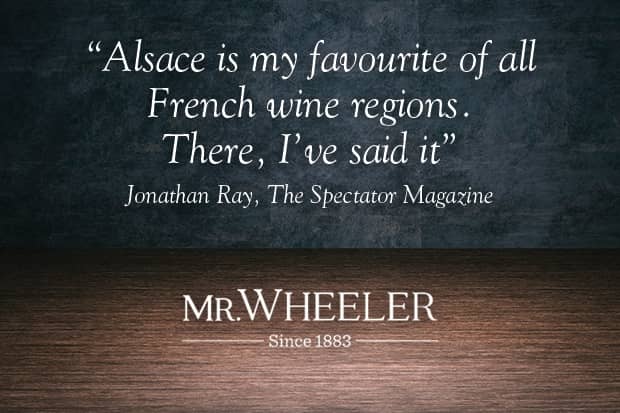Alsace is my favourite of all French wine regions. There, I’ve said it. Bordered by the Vosges and the Rhine, it’s achingly pretty with rolling, wooded hills and exquisite medieval villages. The food is sublime (26 Michelin-starred restaurants), the climate benign (second lowest rainfall in all of France) and the wines, well, they’re stunning, from bone dry whites to sumptuously sweet late harvest wines and tasty Pinot Noir reds.
Apart from a smattering of excellent co-operatives, the wineries are nearly all family-owned, boasting long, unbroken histories despite Alsace having been the battleground of Europe for centuries, enduring such bust-ups as the Thirty Years War, the Franco-Prussian War and two world wars.
The 2019 Pinot Gris, Hospices de Colmar (1) comes from one of the most youthful domaines, founded as recently as 1895, albeit with a vineyard first planted in 1255. A wonderful expression of this grape, the wine’s soft, supple, aromatic and creamy and, while rich and exotically fruity, it finishes delectably dry. £15.95 down from £17.45.
The 2019 Classic Riesling, Famille Hugel (2) is just that: classic Riesling from a venerable house, founded in 1639. I love the Hugels’ wines and this, their signature vino, is just about perfect: crisp, clean, dry, zesty, elegant with fresh apple notes and whispers of honey. £16.95 down from £18.95.
The 2016 Riesling Via Saint-Jacques, Schieferkopf (3) is another fine example of Alsace’s most revered grape, from an estate owned by that titan of the Rhône, Michel Chapoutier. Malolactic fermentation and ten months in oak foudres makes it weightier and toastier than the Hugel version with plenty of fresh, spicy citrus too. £17.95 down from £19.95.
The 2019 Riesling, Rolly Gassmann (4), from families making wine since 1611, is produced using organically/biodynamically farmed fruit, although uncertified. With hints of honey, apples and inimitable Riesling petrol on the nose, the wine reveals layers of intense white stone fruit and citrus backed by a clean, dry finish. It’s gorgeous. £18.95 down from £21.45.
The 2017 Gewürztraminer, Trimbach (5) is one of my desert island wines, a bottle I can drain in a sitting. The Trimbachs (est. 1626) understand this most flamboyant and exuberant of grapes as well as anyone, taming and controlling it with real panache. Crammed with exotic lychee fruit, it’s headily spicy and aromatic but still manages to finish dry. It’s ridiculously enjoyable. £19.95 down from £21.95.
The 2017 Zind, Domaine Zind Humbrecht (6) is a comparative rarity in this land of single varietals, being a blend of 70 per cent Chardonnay (almost unheard of here) and 30 per cent Auxerrois. Aromatic, generous and fruity, it’s fresh and lively but dry on the finish. £20.95 down from £22.95.
Crémant d’Alsace is the most widely drunk traditional method fizz in France after champagne and the Crémant d’Alsace Blanc de Blancs, Domaine Viticole de la Ville de Colmar (7) — a blend of Auxerrois, Pinot Blanc, Pinot Gris and Riesling — is so gloriously gluggable I simply had to include it. £18.95 down from £20.95.
Finally, for lovers of the very best, we’ve a magnificent trio of what I might term Alsace Aces. The 2011 Gewürztraminer ‘Grossi Laüe’, Famille Hugel, 2013 Cuvée Frederic Emile Riesling, Trimbach and 2018 Riesling Grand Cru Brand, Domaine Zind-Humbrecht are quite jaw-droppingly fine examples of this region and of these grapes, from families that boast almost 1,200 years of winemaking between them. Absurdly under-priced compared to the equivalent grands crus of Bordeaux, Burgundy and Champagne, these are wines to linger over, caress and adore. £295 for two bottles of each.
The mixed case has two bottles each of wines 1-6. Wine 7 is available by the dozen and the Alsace Aces box has two bottles each of the three wines outlined above. Delivery, as ever, is free.
For the chance to win a prize of six bottles of superb Alsace wines, go to www.spectator.co.uk/alsace







Comments